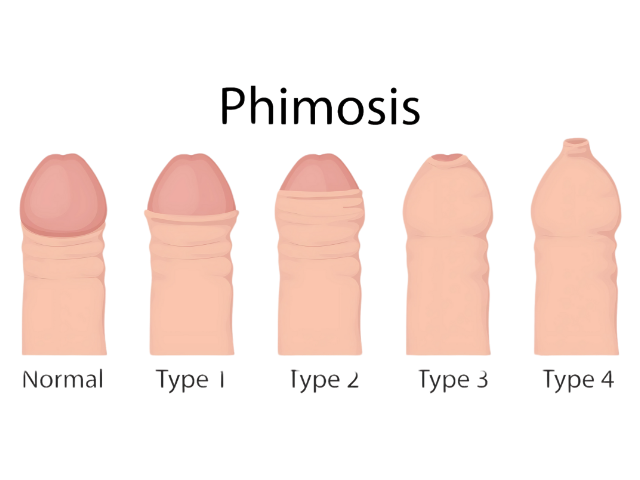Phimosis is a condition where the foreskin cannot be retracted over the glans, causing discomfort, infections, and urinary issues. At KK Virat Hospital, Karimnagar, we offer advanced laser circumcision for a safe and effective solution. Our expert team ensures minimal pain, faster recovery, and long-lasting results. Book a consultation today for specialized phimosis treatment.
What is Phimosis?
Phimosis is a condition where the foreskin of the penis cannot be pulled back over the glans. It is common in newborns and usually resolves by adolescence. However, in some adults, phimosis can persist and cause discomfort, infections, or difficulty with urination and sexual activity.

Types of Phimosis
Physiological phimosis is naturally occurring at birth and resolves on its own in most cases. Non-surgical treatments like steroid creams may help if it persists. Pathological phimosis, on the other hand, is caused by scarring, infection, or injury and can affect individuals of any age, often requiring medical or surgical intervention.
Diagnosis of Phimosis
The diagnosis of phimosis involves a physical examination by a urologist, an assessment of medical and surgical history, and an evaluation of symptoms such as pain, swelling, or infections. Based on the severity, doctors recommend non-surgical or surgical treatments.
Surgical Treatment Options
Laser circumcision is a minimally invasive procedure that uses a laser to precisely cut and remove the foreskin, leading to less bleeding and faster recovery.
Stapler circumcision uses a stapler device for quick and efficient foreskin removal, leaving a silicone ring that falls off in 7-10 days. Open circumcision is the traditional surgical method using a scalpel or scissors, requiring a longer recovery period and carrying a higher risk of infection compared to laser or stapler methods.
Why Choose Circumcision for Phimosis?
Circumcision offers a permanent solution to phimosis. It reduces the risk of urinary tract infections (UTIs), lowers the chance of sexually transmitted diseases (STDs), and helps maintain better penile hygiene.
Recovery After Phimosis Surgery
Recovery time typically lasts 7-10 days. Postoperative care includes keeping the surgical site dry for 48 hours, avoiding alcohol and smoking, drinking sufficient water, and refraining from sexual activity and strenuous exercises until advised by a doctor.
Cost & Insurance Coverage
The cost of surgery varies depending on the method used, patient condition, hospital facilities, and postoperative care.
Most health insurance policies cover phimosis surgery if deemed medically necessary, although cosmetic or religious circumcision may not be covered.
Non-Surgical Treatments for Phimosis
Medications such as antibiotics or antifungal creams and steroid-based ointments (e.g., Lotrimin, Cyclosporine, Methotrexate) can help manage phimosis.
Home remedies include foreskin stretching exercises, coconut oil application for easier retraction, and proper hygiene to prevent infections.
Best Way to Cure Phimosis
Laser circumcision is the most effective, safe, and advanced treatment option. It ensures minimal bleeding, faster healing, and a lower risk of complications.
Phimosis in Adulthood
While common in newborns, phimosis in adults can cause discomfort, infections, and other complications. Seeking medical advice early can prevent severe issues.
Side Effects of Phimosis Surgery
While generally safe, possible side effects of phimosis surgery include mild swelling and discomfort, minor bleeding, risk of infection (rare), and scar tissue formation.
What if Phimosis is Left Untreated?
Untreated phimosis can lead to serious complications such as frequent infections, pain during urination or erection, and an increased risk of penile cancer (rare but possible). In severe cases, it may cause tissue damage or loss of penis function.
Phimosis vs. Paraphimosis
Phimosis occurs when the foreskin cannot be retracted, whereas paraphimosis happens when the foreskin is retracted but cannot return to its normal position. Phimosis is not a medical emergency, but paraphimosis requires immediate medical attention. Phimosis can cause pain, swelling, and urinary issues, while paraphimosis can lead to tissue damage and necrosis if untreated. Treatment options include ointments or circumcision for phimosis, while paraphimosis often requires emergency circumcision.
Why Choose KK Virat Hospital for Phimosis Treatment?
At KK Virat Super Speacility Hospital, Karimnagar, we offer advanced prostatectomy procedures with expert care and precision. Our skilled urologists use the latest laser and robotic-assisted techniques for faster recovery and minimal complications. With modern facilities, comprehensive care, and affordable pricing with insurance support, we ensure the best prostate treatment for our patients.
Your Health, Our Priority – Book Your Consultation Today!
At KK Virat Hospital, Karimnagar, we ensure safe, advanced, and confidential care tailored to your needs.
- Call Us Directly: Get in touch with our medical coordinators to schedule an appointment with an expert urologist.
- Direct Visit: You can visit our hospital directly by carrying your previous medical records if you have a medical history. However, admission will be based on the doctor’s recommendation.
How long does phimosis surgery take?
Phimosis surgery, such as laser circumcision, typically takes 15 to 30 minutes, depending on the procedure used.
How long does it take to recover after a phimosis surgery?
Recovery usually takes 7 to 10 days, with most patients resuming normal activities within a week. Complete healing may take a few weeks.
How can I cure phimosis myself?
Mild cases of phimosis can be managed with foreskin stretching exercises, steroid creams, and proper hygiene. However, severe cases may require medical intervention.
Is phimosis surgery painful?
The procedure is performed under local or general anesthesia, so there is minimal pain. Some discomfort and swelling may occur after surgery but can be managed with painkillers.
What are the best treatment options for phimosis?
Treatment options include steroid creams, foreskin stretching, and surgical procedures like laser or stapler circumcision, depending on severity.
Is laser circumcision better than traditional circumcision?
Yes, laser circumcision is less invasive, causes minimal bleeding, has a faster recovery time, and reduces the risk of infection compared to traditional methods.
Will insurance cover my phimosis surgery?
Many health insurance policies cover phimosis surgery if it is medically necessary. Cosmetic circumcision may not be covered.
Can adults get phimosis?
Yes, phimosis can occur in adults due to scarring, infections, or chronic inflammation, requiring medical treatment.
What happens if phimosis is left untreated?
Untreated phimosis can lead to frequent infections, pain, difficulty urinating, and even an increased risk of penile cancer (rare but possible).
When should I see a doctor for phimosis?
You should consult a doctor if you experience pain, swelling, infections, or difficulty retracting the foreskin, as early treatment can prevent complications.


